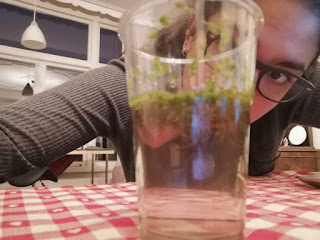Improving Plants
Pollination
Duckweed is a self-pollinating plant, pollination is very hard to
achieve since flowering is extremely rare. If the plant blooms,
wind-pollination, and insect pollination occur. Normally Lemna minor reproduces
vegetatively. (Rancha C, 2018)(“Biology of Plants:
Pollination,” n.d.)
Transgenic Plants in Agriculture?
 |
| Picture 1: Inspecting Self-harvested Duckweed |
In my opinion, this is a very sensitive
topic. Until now I have serious doubts about the use of transgenic plants when
it comes to agriculture.
According to Science Daily, transgenic
plants are the ones that have been genetically engineered, a breeding approach
that uses recombinant DNA techniques to create plants with new characteristics.
Also known as GMOs. (Science
Daily, n.d.) Even though humans have been genetically modifying
plants for thousands of years by breeding them in order to choose the beneficial
traits and expressing the genes throughout generations, GMOs go even further
since there the traits are chosen and genetically introduced.
On the one hand, the use of GMOs has
made many things possible in agriculture like increasing the yields. Especially
when the world's population increases every second and it is estimated to reach
10 billion by 2050 many of us start to wonder, how are we going to reach food
security without transgenic plants?
GMOs have also created great
opportunities for improving the nutritional value of food, for example, the
creation of Golden Rice, a cheap good solution for delivering vitamin A. GMOs
also helped to save the papaya industry in Hawaii.
On the other hand, one of the biggest
reasons for being against GMOs is the risk that gene flow can represent. With
this I refer to the mixing of traditional crops and GMO crops, this can happen
due to wind and or insect-pollination. The risk of gene flow can introduce new
and unwanted characteristics in crops. (Silvia,
n.d.)
One popular use of GMOs is the
introduction of a gene which makes most of the cash crops, especially in the US,
resistant to the pesticide glyphosate. This might seem like a wonderful idea
but in reality, it has only led to an increase in the use of pesticides
worldwide. This makes me think, should we really be against GMOs or actually
against the big food corporations who are the ones in charge of our food supply?
Maybe if GMOs are used correctly, they
could be a great solution for what is yet to come. What about the possible creation of crops
that are resilient to climate change, that can resist droughts or flows. Others can mitigate climate change by for example synthesizing nitrogen from the
air or collecting much more carbon from the atmosphere.
Breeding
Duckweed is nowadays
genetically modified in order to improve its industrial applications and
increase the possible bioenergy production and improve its pharmaceutical
applications.(Van
Hoeck et al., 2015)
References:
Biology of Plants:
Pollination. (n.d.). Retrieved September 20, 2019, from
http://www.mbgnet.net/bioplants/pollination.html
Rancha C. (2018).
Difference Between Self-Pollination and Cross-Pollination (with Comparison
Chart) - Bio Differences. Retrieved September 20, 2019, from
https://biodifferences.com/difference-between-self-pollination-and-cross-pollination.html
Science Daily. (n.d.).
Transgenic plants. Retrieved September 20, 2019, from
https://www.sciencedaily.com/terms/transgenic_plants.htm
Silvia, C. (n.d.). Are
GMOs good or bad? | TED-Ed. Retrieved September 28, 2019, from
https://ed.ted.com/featured/0HAnxvLF#watch
Van Hoeck, A., Horemans, N., Monsieurs, P.,
Cao, H. X., Vandenhove, H., & Blust, R. (2015). The first draft genome of
the aquatic model plant Lemna minor opens the route for future stress
physiology research and biotechnological applications. Biotechnology for
Biofuels, 8(1), 188. https://doi.org/10.1186/s13068-015-0381-1



Comments
Post a Comment